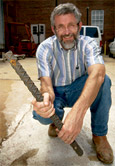 Dr. Andrew Graettinger, assistant professor of civil and environmental engineering, and Dr. Philip Johnson, associate professor of civil and environmental engineering, have developed a method of drilling long, straight, small holes in typical building materials without compromising the strength of the structure. This new method will be used for building stabilization, especially in areas that are considered earthquake zones.Masonry structures can withstand tremendous vertical loads, but problems arise when the structure moves horizontally, as happens during the shaking of an earthquake. Steel reinforcing bars inserted vertically and horizontally through the walls can stabilize the structure, but conventional drilling equipment cannot be controlled well enough to drill holes into an existing wall.
Dr. Andrew Graettinger, assistant professor of civil and environmental engineering, and Dr. Philip Johnson, associate professor of civil and environmental engineering, have developed a method of drilling long, straight, small holes in typical building materials without compromising the strength of the structure. This new method will be used for building stabilization, especially in areas that are considered earthquake zones.Masonry structures can withstand tremendous vertical loads, but problems arise when the structure moves horizontally, as happens during the shaking of an earthquake. Steel reinforcing bars inserted vertically and horizontally through the walls can stabilize the structure, but conventional drilling equipment cannot be controlled well enough to drill holes into an existing wall.

Graettinger and Johnson developed a new waterjet drill that makes long holes that are smaller and straighter than any other current drill. The waterjet is also portable, making it easy to bring to and move around the work site. They modified a pressure washer to incorporate grit into its water stream. The mixture of water, polymer and grit shoots out of a 1/4-inch drill rod that is connected to an abrasive injection system and a 5,000-p.s.i. pressure washer. At 545 miles per hour, the mixture sands and washes away almost any material including steel, concrete and brick.
The holes can be used for the insertion of stabilizing bars to tie a structure together internally to resist shaking. This new method could be used to preserve historic structures and save thousands of dollars in construction costs.